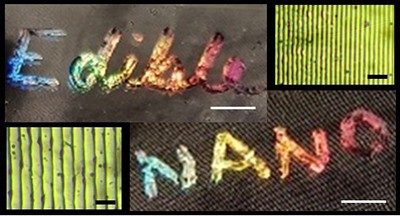FOR IMMEDIATE RELEASE
ACS News Service Weekly PressPac: February 17, 2021
Edible holograms could someday decorate foods
“Direct Printing of Nanostructured Holograms on Consumable Substrates”
ACS Nano
Holograms are everywhere, from driver’s licenses to credit cards to product packaging. And now, edible holograms could someday enhance foods. Researchers reporting in ACS Nano have developed a laser-based method to print nanostructured holograms on dried corn syrup films. The edible holograms could also be used to ensure food safety, label a product or indicate sugar content, the researchers say.
Most holograms are imprinted with lasers onto metal surfaces, such as aluminum, but the materials aren’t edible. For foods, holograms made with nanoparticles have been proposed, but the tiny particles can generate reactive oxygen species, which might be harmful for people to eat. In a different approach, food scientists have molded edible holograms onto chocolate, but the process only works for certain types of the confection, and a different mold is needed for each hologram design. Bader AlQattan, Haider Butt and colleagues wanted to find a safe, fast and versatile way to pattern edible holograms onto a variety of foods.
To develop their method, the researchers made a solution of corn syrup, vanilla and water and dried it into a thin film. They coated the film with a fine layer of non-toxic black dye. Then, they used a technique called direct laser interference patterning to etch off most of the dye, leaving behind raised, nanoscale lines that formed a diffraction grating. When struck by light, the nanostructure diffracted the light into a rainbow pattern, with different colors appearing at different angles of viewing. The team could control the intensity and range of colors by varying the spacing between lines in the grating or the sugar content of the corn syrup film. Before edible holograms are ready to hit store shelves, however, the researchers want to adapt the method to a food-grade dye that could replace the synthetic black dye used in these pilot experiments.
The authors acknowledge funding from Khalifa University, Sandooq Al Watan, Aldar Properties and the Engineering and Physical Sciences Research Council.
###
The American Chemical Society (ACS) is a nonprofit organization chartered by the U.S. Congress. ACS’ mission is to advance the broader chemistry enterprise and its practitioners for the benefit of Earth and all its people. The Society is a global leader in promoting excellence in science education and providing access to chemistry-related information and research through its multiple research solutions, peer-reviewed journals, scientific conferences, eBooks and weekly news periodical Chemical & Engineering News. ACS journals are among the most cited, most trusted and most read within the scientific literature; however, ACS itself does not conduct chemical research. As a leader in scientific information solutions, its CAS division partners with global innovators to accelerate breakthroughs by curating, connecting and analyzing the world’s scientific knowledge. ACS’ main offices are in Washington, D.C., and Columbus, Ohio.
To automatically receive press releases from the American Chemical Society, contact newsroom@acs.org.
Note: ACS does not conduct research, but publishes and publicizes peer-reviewed scientific studies.
Media Contact
ACS Newsroom
newsroom@acs.org

View the image

